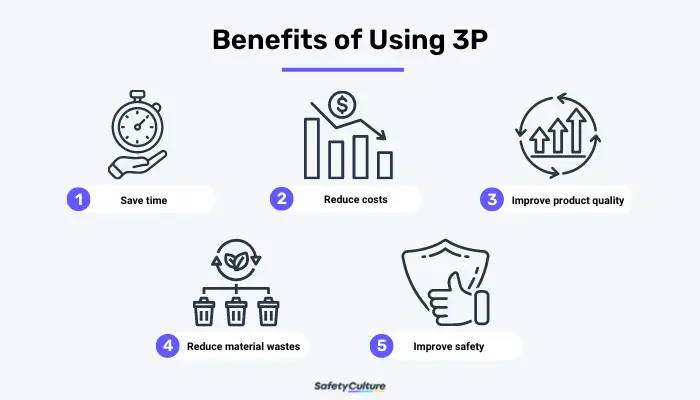What is 3P Method?
3P stands for Production, Preparation, and Process. It is a lean manufacturing method that helps businesses to assess and improve their production processes. The goal of 3P is to streamline production, eliminate waste through product, and increase efficiency. First, companies must identify all of the steps in their production process and any bottlenecks or waste sources.
They then need to create a plan for improving the process, taking into account the resources and constraints of the business. Once the plan is set, companies can implement the changes and track their progress to achieve their desired results.

Employees working together
Advantages and Disadvantages of Using 3P
The advantages and disadvantages of using 3P are listed below.
Advantages:
- Increased communication and collaboration between departments.
- Improved quality control.
- Reduced lead times.
- Decreased costs.
Disadvantages:
- It needs a lot of planning and communication to get done.
- It can be disruptive to existing processes and systems.
- It might require a significant investment of time and money at the start.
How is 3P Related to Kaizen?
Kaizen is a philosophy of incremental improvement. It means that, rather than making sweeping changes all at once, Kaizen advocates for constantly making minor changes to slowly but steadily improve.
Meanwhile, 3P is a tool often used in Kaizen. 3P aids in identifying and streamlining the steps necessary to complete a task. By breaking down a task into steps, you can more easily see improvements.
For example, if you are trying to improve the efficiency of your assembly line. Using the 3P tool, you would break down the process of your assembly line into steps, which might look something like this:
- Receiving raw materials
- Inspecting raw materials
- Cutting raw materials to size
- Assembling the product
- Inspecting the assembled product
- Packaging the product
- Shipping the finished product
By looking at each step, you might identify areas where there is room for improvement. For example, you might find it more efficient to move the raw materials closer to the assembly line, or products could be shipped out quickly if packaged differently.
You can more easily see where improvements can be made by breaking processes down into steps. It helps ensure that Kaizen is a continuous process of progress rather than a one-time event.
When to Use 3P Methodology?
Let’s look at a few examples where 3P initiatives have been successful.
- When you’re releasing a new product.
- When demand for a product or service changes dramatically, necessitating the replacement of a production line.
- When you’re shifting production to a new site.
- When a significant design overhaul is required as a result of external competition.
- When you need to open a lot of production space.
- When your manufacturing process has serious quality issues that you have been unable to address.
A 3P project is often completed with a new product release, but it may also refresh a design. The production preparation process for an existing operation would be a complete makeover, unlike Kaizen, which usually entails minor changes.
The goal of 3P is to develop goods that may be manufactured in a flow process. It is the same as manufacturing design, but it’s crammed into a short period.
How to Practice 3P?
Lean tools such as 3P are one of the most powerful Lean techniques accessible, with the potential to unleash creativity, rapid learning, and improved collaboration. Because 3P is also a more “complex” continuous improvement procedure, organizations that have used methods like Kaizen have a better chance of success.
If you consider implementing the 3P approach in your organization, remember these things:
- Make sure you know your customer and what they want from a solution before attempting anything else.
- Define the purpose and scope of your project. What do you want to achieve?
- Rather than focusing on existing procedures, consider your desired state and determine if 3P is the most effective method. The approach is most useful when demand conditions change, as in the case of a new facility or product line creation.
- 3P is especially effective when there’s a deadline.
Digitize the way you Work
Empower your team with SafetyCulture to perform checks, train staff, report issues, and automate tasks with our digital platform.
Get Started for FreeTop Reasons for Using 3P
There are many reasons for using 3P in your organizations, but here are a few of the most important ones:

- To improve efficiency and save time – By carefully examining every aspect of the manufacturing process, 3P can help identify areas where time is being wasted. Then, use this information to save time and increase efficiency.
- To reduce costs – By identifying and eliminating wasteful practices, 3P can help reduce the overall cost of manufacturing.
- To improve quality – 3P helps find areas where quality is being compromised by looking at every step of the manufacturing process. Then, use this information to make the final product better.
- To reduce material waste – One of the main goals of 3P is to reduce or eliminate waste in the manufacturing process. By identifying and eliminating wasteful practices, 3P can help to reduce the amount of waste produced.
- To improve safety – Another critical goal of 3P is to enhance security in the workplace. By identifying and eliminating unsafe practices, 3P can help to make the workplace safer for everyone involved.
Methods and Implementation
3P follows a specific methodology designed to help identify areas of improvement in the manufacturing process. Here are the steps that usually happen in a 3P event.
Define the Goals or Needs of Product or Process Design
The team’s goal is to figure out the essential customer requirements. The project team deconstructs a product design or prototype into parts and raw materials to see how each works.
Create Diagrams
A Fishbone diagram or equivalent method shows the flow from raw material to finished product. Next, the team analyzes each branch of the diagram and brainstorms terms (e.g., roll, rotate, form, bend) to describe the transformation (or “change”) made at each point.
Find Examples in Nature
The project team looks for real-world examples of each process keyword. For example, a group might look at how a plant grows in nature to determine what “growth” means. Then, the examples are put into groups, and the ones that show the process best are chosen. Next, team members discuss how a particular manufacturing process can use the same methods found in nature.
Sketch and Evaluate the Process
In these situations, sub-teams are established, and each member is assigned a different method for completing the operation. The best sketch is selected for basic mock-ups.
Create and Select Process Prototypes
The team creates a low-cost prototype and then tests the selected procedure, spending several days (if necessary) working with many mock-up variations to ensure it fulfills the requirements.
Review the Plans
After an idea has been tested, it is shown to a larger group of people to get their feedback.
Create a Project Implementation Strategy
Suppose the project is chosen to go forward. In that case, a project implementation leader is selected who works with the team to set milestones, establish processes, and define resources and distribution of responsibilities.



